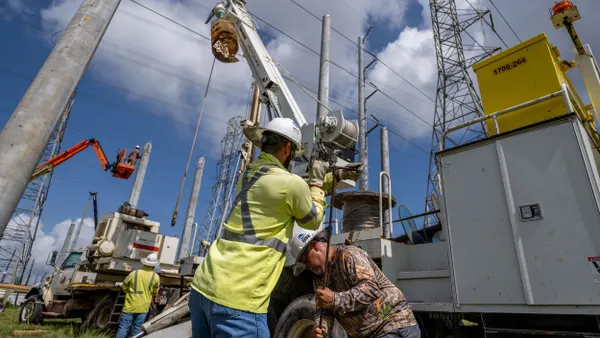Dive Brief:
-
Allete and Grid United plan to build a $2.5 billion, 385-mile high-voltage direct-current transmission line from central North Dakota to Colstrip, Montana, providing a link that would more than double the transfer capacity between the Western and Eastern interconnections, the companies said Monday.
-
The companies this year intend to start federal and state permitting on the up to 600-kV North Plains Connector project, which would provide 3,000 MW of bi-directional capacity in 2029 when it is tentatively set to begin operating.
-
“This innovative project is an important step toward a resilient and reliable energy grid across a wide area of the country and ties into important transmission projects being developed in the Upper Midwest and the Western Interconnection,” Bethany Owen, Allete chair, president and CEO, said in a statement.
Dive Insight:
The proposed North Plains Connector is one of four transmission projects Houston-based Grid United is developing between U.S. interconnections.
The Western and Eastern interconnections, along with the Electric Reliability Council of Texas, make up the U.S. grid, but have little capacity to share electricity.
Adding transmission capacity between the interconnections would reduce electricity costs by allowing wind, solar and natural gas-fired generation to flow more freely across broad regions, according to a study by the National Renewable Energy Laboratory.
Seven high-voltage links allow only 1,320 MW to move between the Eastern and Western interconnections, NREL noted in the study. ERCOT also has little import-export capacity.
The North Plains Connector project aims to link the Midcontinent Independent System Operator, the Western Interconnection and the Southwest Power Pool, easing congestion on the transmission system, and enabling fast sharing of electricity across a vast area with diverse weather patterns, the companies said.

One end of the line would be in Colstrip, Montana, home to a major coal-fired power plant and a two-segment 500-kV transmission system that delivers power to utilities in the Pacific Northwest. Meanwhile, MISO is expanding its transmission network in the Dakotas, Minnesota and the rest of its northern and central regions through its long-range transmission planning process.
Allete, based in Duluth, Minnesota, plans to own at least 35% of the project and to operate it.
Other utilities will likely join the project, in part so they can take advantage of different resource options, according to Michael Skelly, Grid United CEO.
United Grid’s transmission projects may follow a develop-transfer model under which the company sells to utilities portions of projects, Skelly said.
The Grid United-Allete partnership is part of a trend of independent transmission companies partnering with utilities, according to Rob Gramlich, Grid Strategies president.
The proposed North Plains Connector project “captures diversity of production at different times in different places so you’d expect power flow switching directions a couple times each day, similar to how the Pacific DC intertie is used,” Gramlich said Tuesday in an email.
Recent extreme weather has highlighted the value of being able to transfer electricity between regions, Skelly said Tuesday. In June 2021, a heat dome over the Northwest caused power prices to soar, while low cost power was available in MISO, he said.
Allete and Grid United have signed a memorandum of understanding to explore transmission opportunities, they said. The companies plan to execute a North Plains Connector development agreement in the first half of this year.
Grid United is backed by Centaurus Capital, according to the company.
Grid United’s proposals come amid a heightened focus by the federal government on transmission development. The Federal Energy Regulatory Commission, for example, has proposed reforms to its transmission planning and cost allocation rules and is considering requiring grid operators to be able to transfer minimum amounts of electricity between each other.
After years of development, the United States is poised for a boom in long-distance transmission, Skelly said, pointing to projects such as Champlain Hudson, SunZia and TransWest Express.
The long-term expansion and extension of renewable energy tax credits in the Inflation Reduction Act led to increased certainty that has flowed through to transmission development, according to Skelly.
“The easiest job in America right now is selling HVDC equipment,” he said.
Editor’s Note: This story has been updated with comments from Michael Skelly and Rob Gramlich















